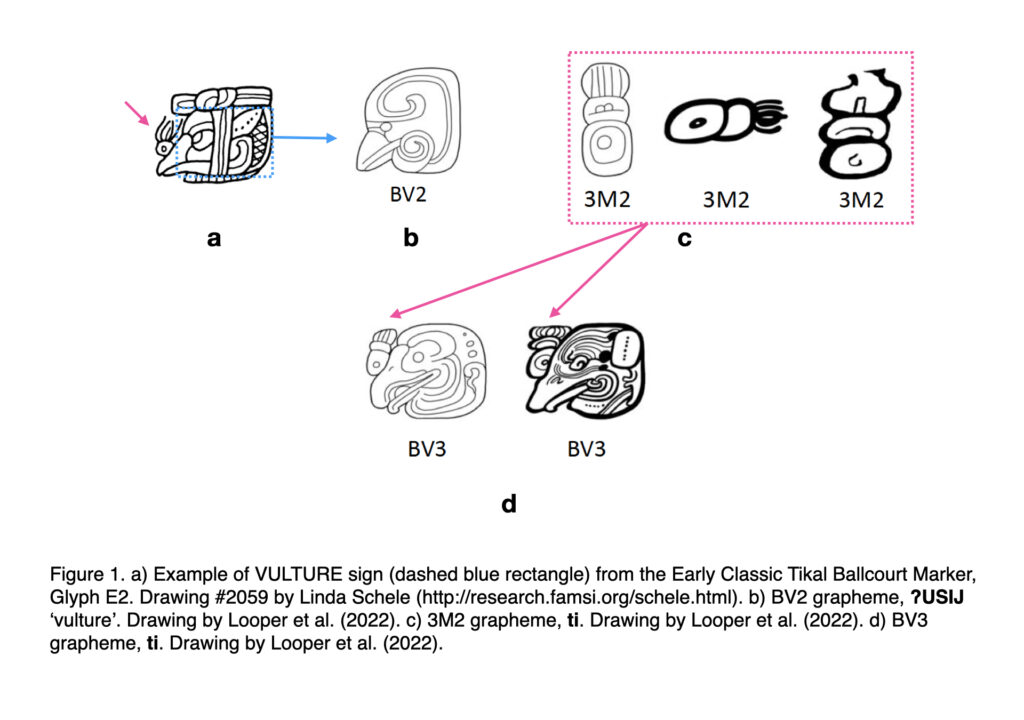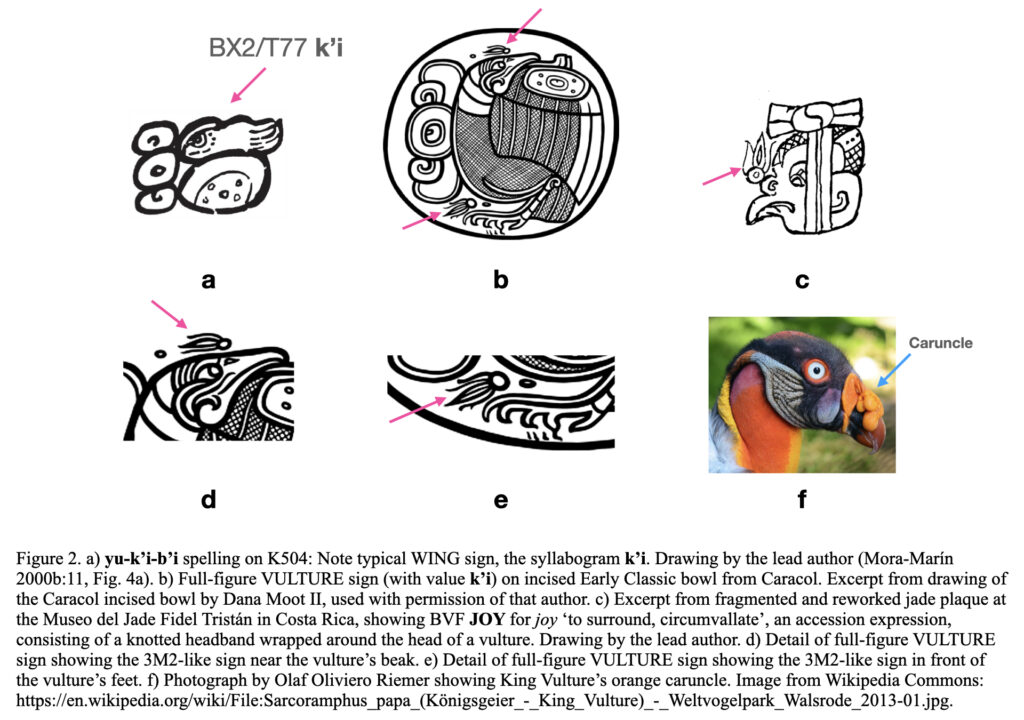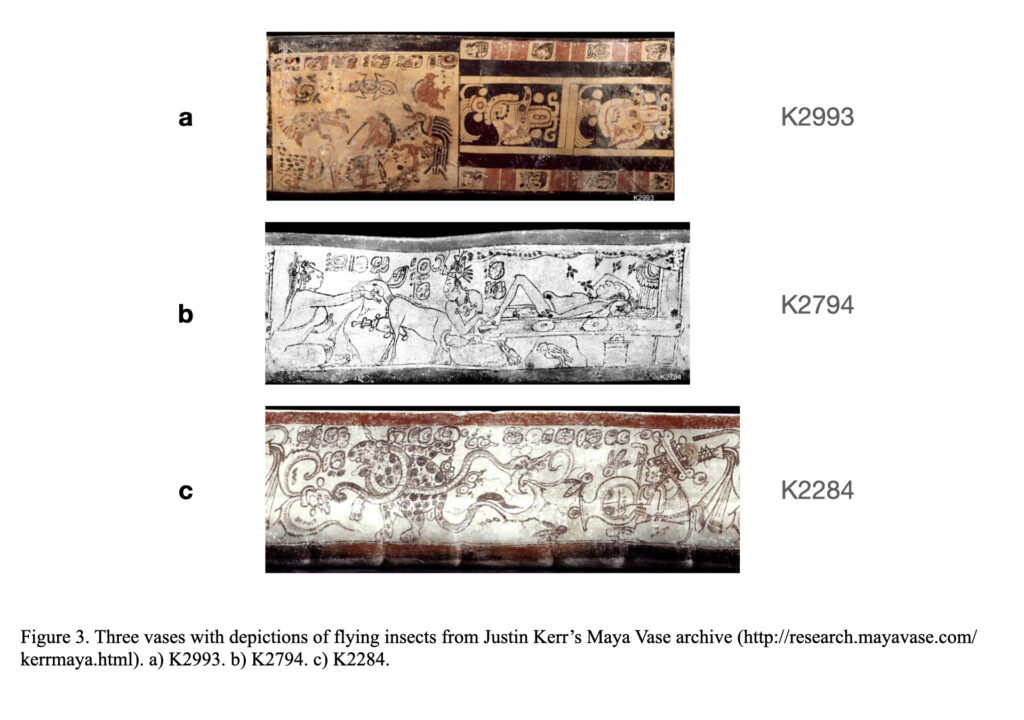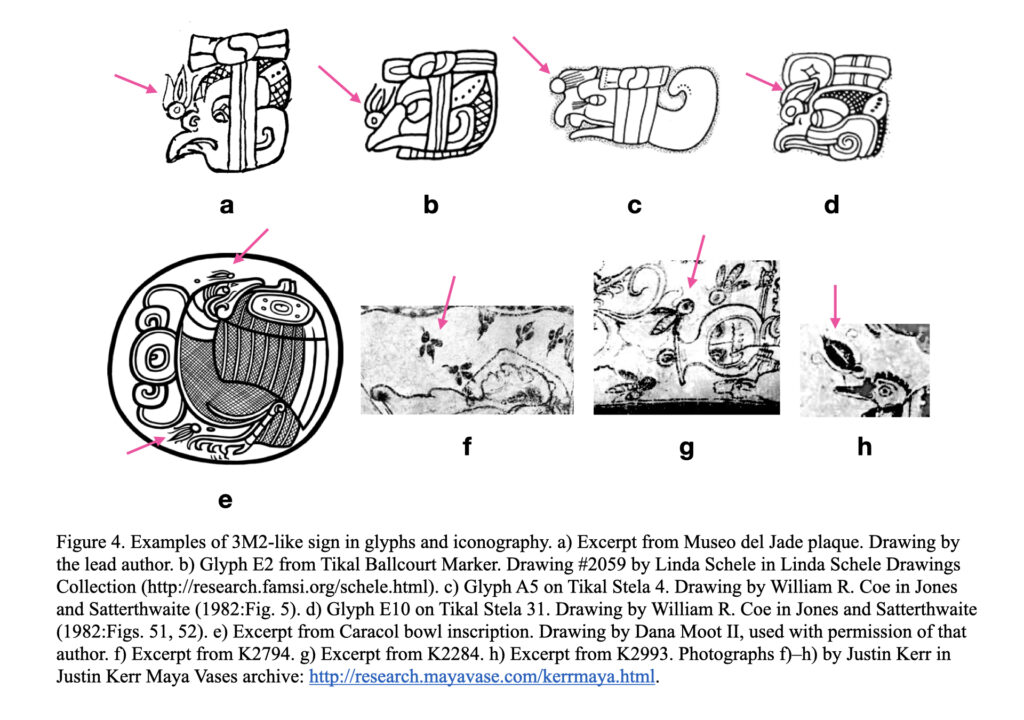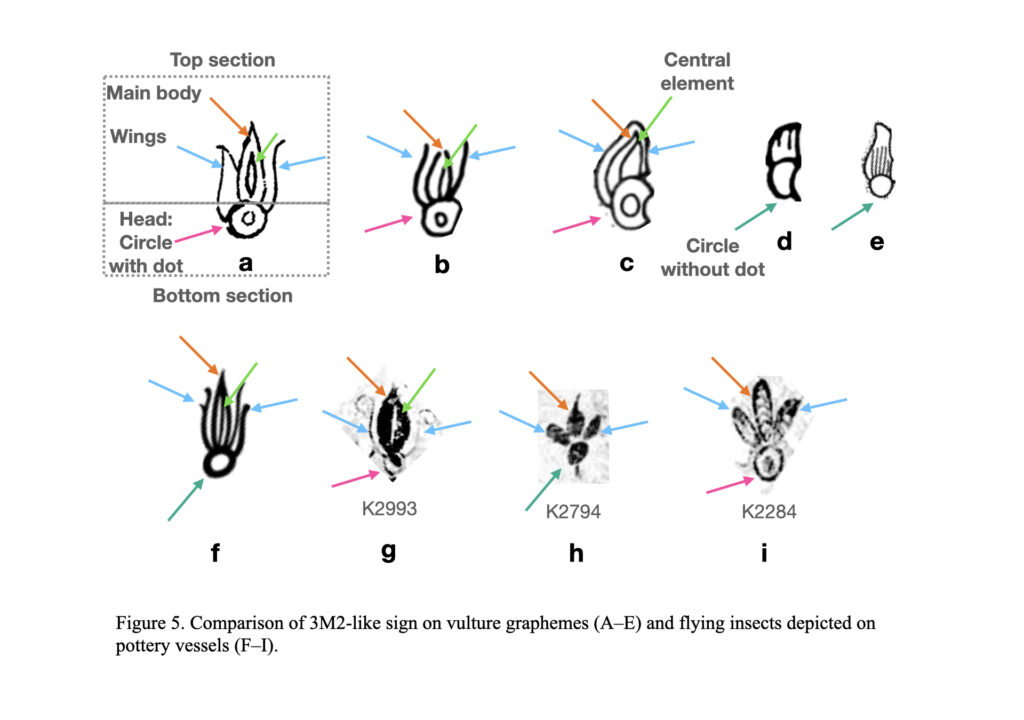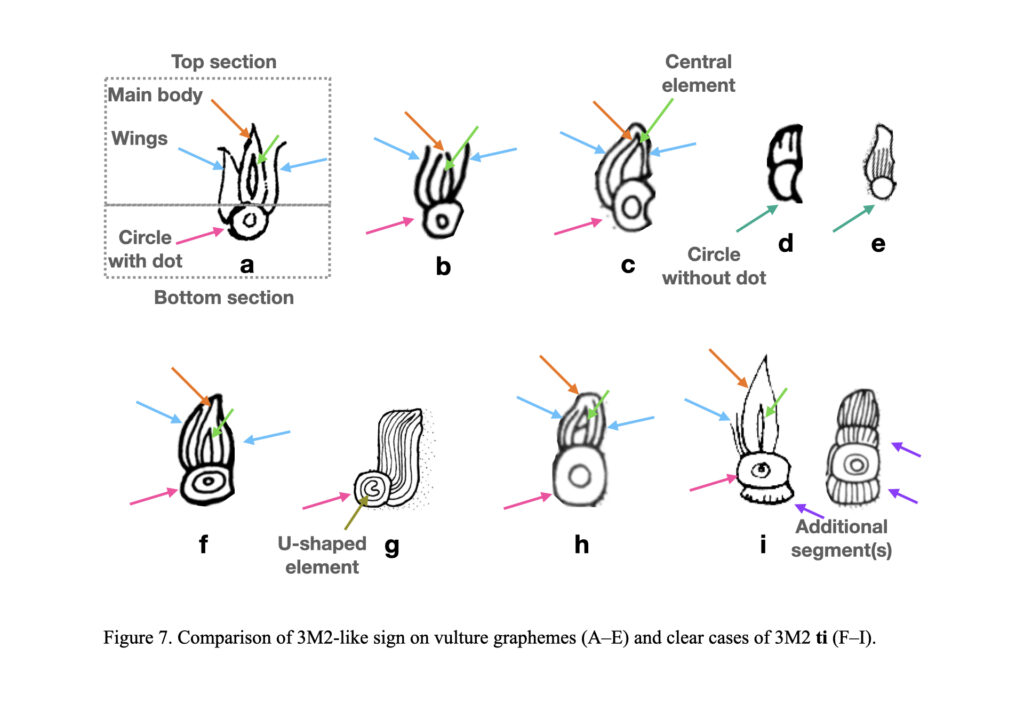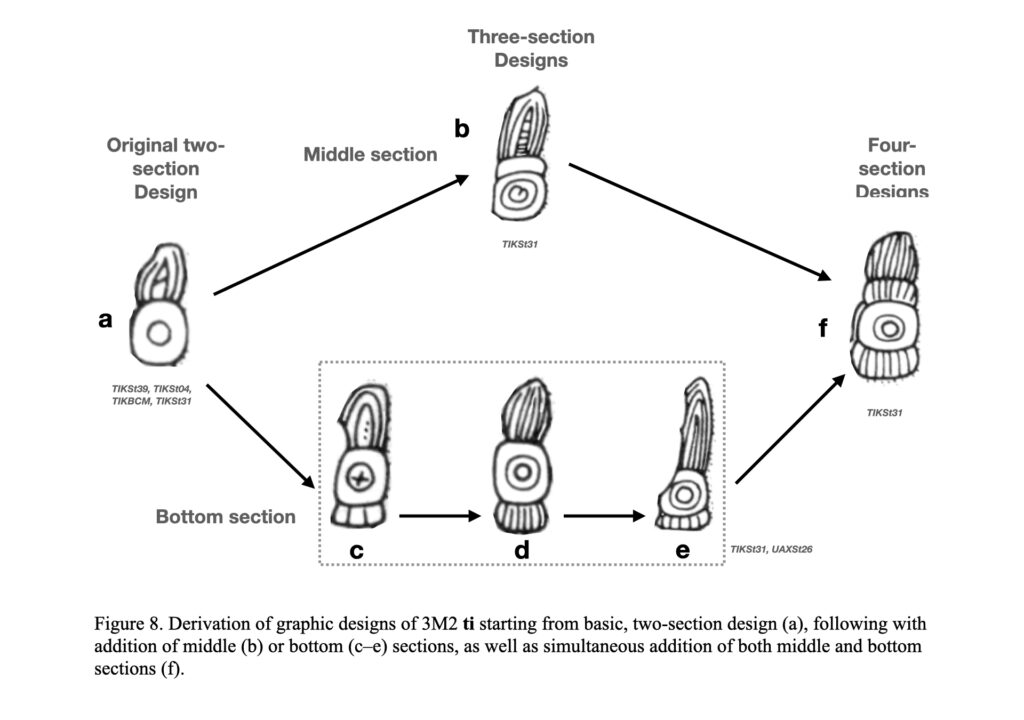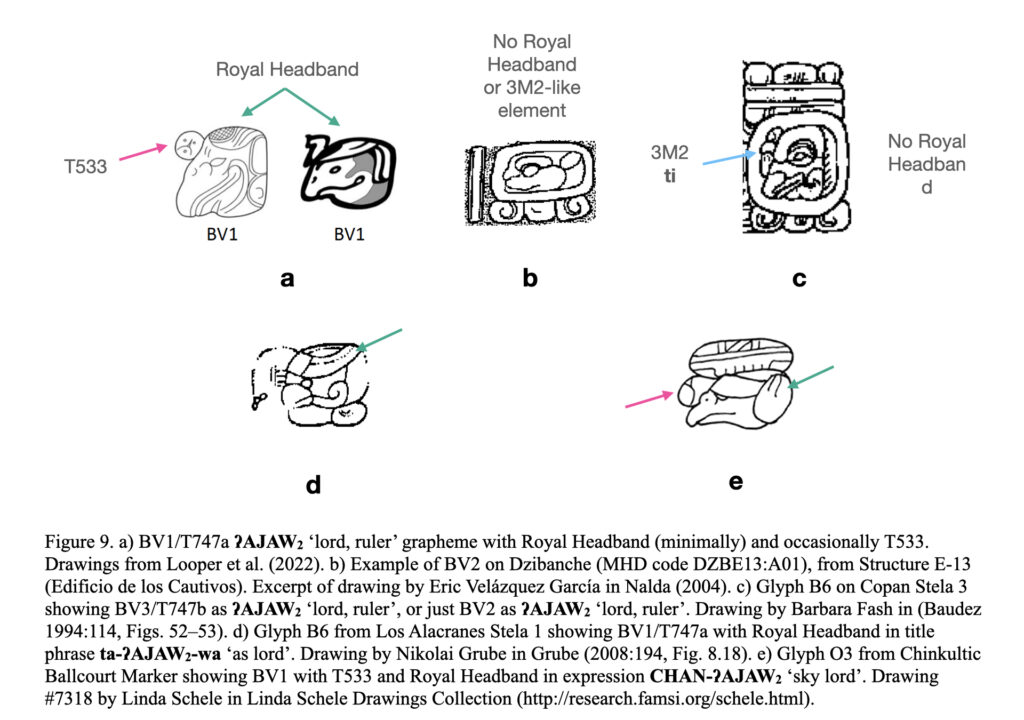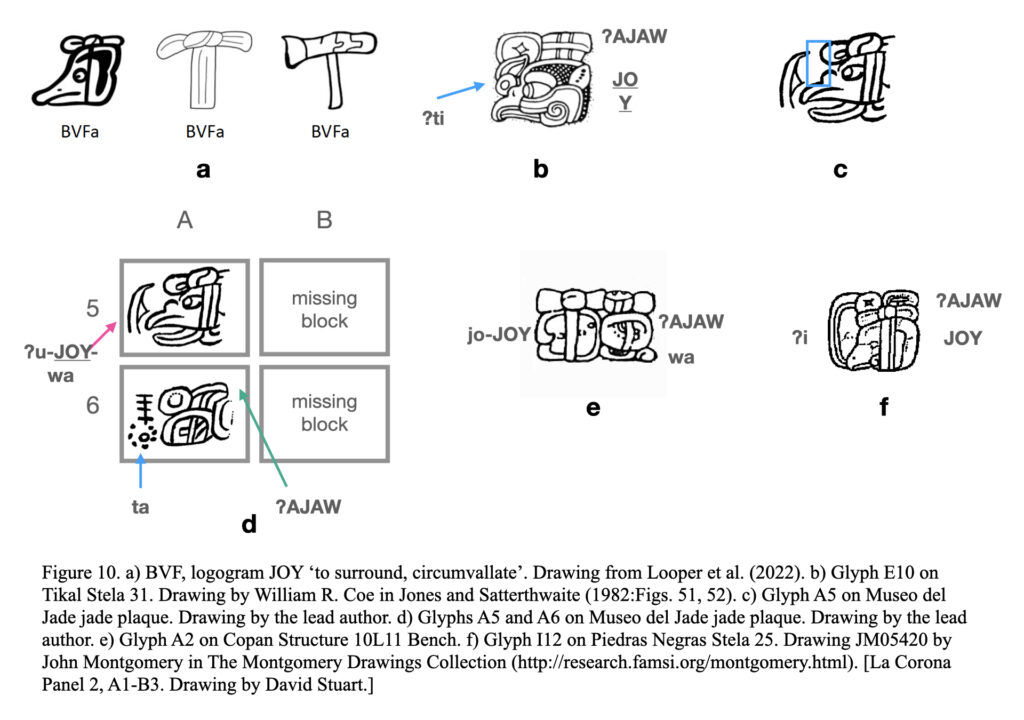Of Flies and Vultures: An Explanation of the Origins of 3M2/T59 ti
David F. Mora-Marín and Amy Glenn Mora
8/17/23, 9/30/23
The present note pertains to the Early Classic (CE 200-600) examples of the VULTURE grapheme (Figure 1A), generally cataloged as BV2 in Looper et al. (2022) (Figure 1B), and functioning as a logogram (“word sign”) ʔUSIJ ‘vulture’ during the Classic period. More specifically, this note pertains to a graphic element that is commonly affixed to the beak on Early Classic examples (see arrow in Figure 1A), an element that strongly resembles the syllable sign or syllabogram ti (Figure 1C), cataloged as grapheme 3M2 in Looper et al. (2022) and T59 in Thompson (1962). In fact, during the Late Classic, the juxtaposition of 3M2 ti and BV2 VULTURE functioned as a syllabogram ti, and as such it receives its own code, BV3/T747b (Figure 1D), though such juxtaposition may not have borne such function in earlier times, as shown below.
Figure 1
Because of this close association between the VULTURE grapheme and 3M2 ti, some scholars have assumed that 3M2 originally functioned, in some way, to disambiguate the bird depicted by BV2 as a vulture. One of these proposed functions of the 3M2-like sign juxtaposed to the VULTURE grapheme relates to the most common function of 3M2 ti in the script: it was used to represent reflexes of the generic preposition *tya of proto-Mayan in the vast majority of its contexts, reconstructed as *tä in proto-Ch’olan by Kaufman and Norman (1984), and presumably acquiring the shape ti in all Ch’olan languages except for Yokot’an only later, perhaps under the influence of Yucatecan *tiʔ. For such reason, authors like Fox and Justeson (1984a, 1984b) have regarded 3M2 as originally bearing a value ta that subsequently derived a value ti through internal linguistic change.
Several authors have also explained the presumed original value ta by proposing that it depicts “a flaming torch,” which would mean that 3M2 was derived acrophonically as ta based on a reflex of proto-Mayan *tyaaj ‘torch’ (Justeson 1984:320). Based on such presumed value ta, some authors (Floyd Lounsbury, Peter Mathews, Berthold Riese, cited in Justeson 1984:355) have even suggested that 3M2 functioned to indicate the logographic value of BV2 as TAʔHOL (i.e. TAʔJOL) based on Ch’ol taʔ=hol (i.e. taʔ=jol) ‘vulture (lit. excrement=head)’, alongside the already demonstrated value K’UCH ‘vulture’ in the Postclassic (CE 900-1521) codices.
More recently, Macri (2021:9–10) supports such association with Ch’olan reflexes of proto-Mayan *tzaaʔ ~ *taaʔ ‘excrement’ (Kaufman with Justeson 2003:293), and argues that the earliest examples of BV3 ti were actually read ta.
Along the similar lines as previous authors, Kettunen (2018:287), has argued that in the context of BV3 ti, the juxtaposition of 3M2 ti and BV2 VULTURE, the 3M2 component represents an anatomical part of the vulture, specifically, “a caruncle attached to the cere of the King Vulture” (Kettunen 2018:287). Unlike previous authors, Kettunen appears to assume that 3M2 only bears a syllabographic value ti, not ta, and his acrophonic derivation for 3M2 ti and BV3 ti is based on the assumption that, as a depiction of the vulture’s caruncle, 3M2 is a pars pro toto (part-for-the-whole) abbreviation of the BV3 grapheme, associating the vulture’s eating of carrion with the Tzeltal verb tiʔ ‘to eat flesh’, a reflex of proto-Mayan *tiʔ ‘to eat/bite (meat/flesh)’.
Below, we suggest that, in fact, 3M2 bore the value ti throughout its history, and that early examples of BV3 (i.e. 32M.BV2) did not bear a value ti or ta at all, but most likely simply ʔUSIJ for ʔusiij ‘vulture’, or other logographic values that the seemingly polyvalent VULTURE grapheme could bear, such as ʔAJAW for ʔajaw ‘ruler’ (with or without the headband determinative).
Before proceeding, though, a disclaimer: There are other possible ways of thinking about the association between 3M2 and the VULTURE sign, not all of them requiring a direct relationship between 3M2 and the VULTURE sign. For instance, an anonymous reviewer of the lead author’s paper on acrophonic derivations (Mora-Marín 2003) suggested the possibility that 3M2 represents “strands of hair above an ear spool,” while Nick Hopkins (personal communication, 2022) has recently suggested that 3M2 represents the tip of a point brush, and that its value may be based acrophonically on ti’ ‘mouth’ with a derived meaning ‘tip’, a matter to which we return toward the end of the paper. These ideas also seemed quite reasonable, up until we uncovered a set of iconographic relationships that we now believe offer a better explanation.
The evidence indicates that the 3M2-like element is not a caruncle! The key to realizing this, that 3M2 does not depict a part of a vulture, and specifically not a caruncle, was the recent discovery of an Early Classic pottery bowl from the site of Caracol, described by Chase and Chase (2014:26–27, Figs. 122a, 123). On that bowl, the glyphic collocation spelling the term y-uk’-ib’ ‘his/her container’ shows a unique rendering; rather than using a simple syllabic sequence yu-k’i-b’i with the WING sign, BX2/T77, the syllabogram k’i (Mora-Marín 2000), as the second sign in the sequence (Figure 2A), the example on this bowl is depicted in full-figure fashion as a vulture, as BV2, with the vulture’s wing displayed very prominently (Figure 2B). Not only does the wing make up about 50 percent of the whole vulture, but the the vulture’s head is also turned back toward the wing, as if pointing to it with its beak, and the syllabogram b’i was infixed within the wing. Whether this example indicates that BV1 could exhibit yet another value, as a syllabogram k’i, or whether we are simply witnessing an idiosyncratic, playful elaboration by a scribe, is unclear. What is worth highlighting here is that the graphic element that appears to be the precursor of 3M2 ti in Early Classic depictions of BV3 (Figure 2C) is found in two locations (Figures 2D-2E): above the vulture’s beak, and to the left of its feet. In other words, it is not depicting a vulture’s caruncle, an anatomical component it does not even resemble to begin with (Figure 2F).
Figure 2
What is it then? We propose that the 3M2-like element juxtaposed to the VULTURE sign is a FLY or more generally a FLYING.INSECT. This is based on its presence by the vulture’s beak and feet, for one, as well as the similarity between the depictions of the 3M2-like element and flying insects. Indeed, we draw attention to three depictions of flying insects on three different pottery vessels, one (K2993) likely from the Early Classic period (Figure 3A), and two (K2794, K2284) from the Late Classic period (Figures 3B–3C).
Figure 3
A more detailed look is warranted. When we compare the examples of the 3M2-like element on several Early Classic VULTURE signs (Figures 4A-5D) to the graphic elements by the beak and feet of the vulture on the Caracol bowl (Figure 4E), and in turn we compare these to the motifs on the pottery vessels (Figures 4F-5H), the same overall shape is in evidence (Figure 5): a graphic design consisting of two major sections (Figure 5A), a bottom section consisting of a circle that sometimes bears a dot inside (Figures 5A–5C, 5G and 5I), and a top section consisting of two sets of elements, a central “main body” that sometimes contains an internal central element, and two “wings” on either side of the central element. In at least two of the pottery vessels, the designs in question can be interpreted as flying insects (Figure 4): the example on K2794 depicts a dying man with a paunch and what seem like flies buzzing around him (Figure 5F); the example on K2284 was described by Justin Kerr (http://www.mayavase.com/tran/trans.html) as showing bees emerging from the mouth of a pot (Figure 4G). The Early Classic example (Figure 4H) shows the 3M2-like element near the beak of a bird, though it is not obviously a vulture, resembling instead a quetzal, as suggested by the crest. Although quetzals typically eat fruit, they also eat insects and small vertebrates (Reid et al. 2010:105), and thus, the example in question could be a depiction of a quetzal trying to catch a flying insect. The example of the full-figure VULTURE sign on the Caracol bowl (Figure 4E) shows the 3M2-like element on two locations ear the vulture, consistent with flies buzzing around the vulture.
Figure 4
Figure 5
The earliest, clear evidence for the use of 3M2 as a syllabogram points to the value ti. The evidence comes from five dated monuments from the second half of the fourth century and the first half of the fifth century: 1) Tikal Stela 39 (TIKSt39, 8.17.0.0.0, ce 376); 2) Tikal Stela 4 (TIKSt04, 8.17.2.16.17, ce 379); 3) Tikal Ballcourt Marker (TIKBCM, 8.19.0.0.0, ce416); 4) Tikal Stela 31 (TIKSt31, 9.0.10.0.0, ce 445); 5) Uaxactun Stela (9.0.10.0.0, ce 445). The first, Tikal Stela 39, shows two cases: one functioning as a syllabogram ti in the spelling ʔu-ʔUH-ti for ʔu[h]t-i-Ø ‘it got finished; it happened’ (Figure 6A), and the other juxtaposed to BV2, the VULTURE sign, in an iconographically-embedded glyphic spelling TZ’AK-b’u-?ʔUSIJ referring to a captured king from Uaxactun (Figure 6B), as noted by Beliaev et al. (2023). The second inscription, Tikal Stela 4 (Figure 6C), shows one example, juxtaposed to the VULTURE sign in the context of the BVF grapheme for JOY, with the full spelling showing JOY-ja. Although quite often epigraphers have read the 3M2 sign in this collocation as the preposition ti (or ta), we will show below that it is merely an iconographic element associated with the VULTURE sign in this context, whatever its value (whether ʔAJAW or ʔUSIJ or JOY). The third text is Tikal’s Ballcourt Marker, showing an example of 3M2 functioning as a syllabogram ti to spell the preposition ti in the phrase ti-LAJUN-ʔAJAW(AL) ’on 10 Ajaw’ (Figure 6D), suggesting that by this date Ch’olan speakers had already incorporated the variant ti into their repertoire alongside tä. The fourth text is Tikal Stela 31, with six examples of 3M2 functioning as a syllabogram ti in the expression ʔUH-ti-ya for ʔu[h]t-i-Ø(-[y]a) ‘since it got finished; it happened’ (Figure 6E), and an example juxtaposed to BV1 in the context of BVF JOY (Figure 6F), presumably intended to be read as jo[h]y-aj-Ø-Ø ‘he was surrounded/circumvallated’ (accession). The fifth example, Uaxactun Stela 26, is found again in the expression ʔUH-ti for ʔu[h]t-i-Ø ‘it got finished; it happened’ (Figure 6G). Lastly, for now, an undated portable text from Tikal (TIKMT011) from Problematic Deposit 22 # 12J-191 also bears a very clear example of 3M2 resembling the flying insect motif (Figure 6H). This text bears Design 6 of ZB1/T168 (Mora-Marín 2021), attested on dated texts from ce 437–554, as well as an example of ZBF/T62 yu showing the central O-shaped element instead of the earlier U-shaped element, a shift that took place after the fifth century, suggesting an early sixth century dating. However, it is not at all clear what 3M2 ti would be used for in this last example.
Figure 6
It is important to note that the earliest examples of 3M2 used as a syllabogram generally point to the value ti, not ta. The only possible exception, the case from the Tikal Ballcourt Marker (Figure 7D), where it spells the generic preposition in a temporal phrase, could be argued to be an instance where 3M2 functions as ta. Nevertheless, given that languages from both Ch’olan branches (Eastern and Western) attest to the preposition ti, and that the preposition tä is reconstructible to proto-Ch’olan based on the evidence from Yokot’an and Ch’orti’, as well as the evidence from the Tzeltalan languages (through forward reconstruction from proto-Greater Tzeltalan to proto-Ch’olan), it is proposed here that proto-Ch’olan should be reconstructed with *tä ~ *ti, with allomorphic variation. The example from the Ballcourt Marker could simply be evidence of such variation. All other spellings spanning ce 376–445 point to either a purely iconographic use of 3M2 (Figures 6B–6C and 6F) or a syllabographic use as ti (Figures 6A, 6D, 6E, 6G).
3M2 ti experienced a rapid series of graphic changes during the Early Classic. To trace them it is necessary to identify the graphic elements that compose 3M2. Figure 7 shows a comparison of the main graphic components of the 3M2-like sign iconographically juxtaposed to the VULTURE signs in Early Classic texts (Figure 7A–7E) with examples of 3M2 ti in the earliest inscriptions (Figure 7F–7I). The earliest epigraphic examples (Figures 7F–7I) typically show a simple division into two sections, a top section and a bottom section, just like the iconographic 3M2-like sign (Figures 7A–7E); however, some show additional sections (Figure 7I).
Figure 7
Figure 8 illustrates such additions using evidence from a single inscription, Tikal Stela 31, but these are representative of the variation found on other texts during the remainder of the fifth century. Indeed, the six clear examples of 3M2 on this monument show wide variation. One of the examples (Figure 8A) corresponds to the earliest version also attested on earlier inscriptions, consisting of the two major sections, already described earlier for the iconographic precursors (cf. Figures 7A–7E). However, the remaining five examples from Stela 31 show the addition of at least one more section, and one of them adds two sections. The example in Figure 8B, though it occurs only once on Stela 31, would become the basis for the most common design of 3M2 for the remainder of the Classic period: it shows three sections, with an additional section inserted in the middle, in between the two original sections. Three more examples (Figures 8C–8E) illustrate the addition of a section at the bottom, below the two original sections. This design is found in additional Early Classic texts, but it eventually was overtaken by the one in Figure 8B. Lastly, one of the examples (Figure 8F) illustrates the addition of two sections, the middle section in between the two original ones, and the new section at the very bottom. This design was rare and its latest attestation on a dated text is the Menil Collection panel (COLHstPan), dated to ce 498, and which also attests to the design in Figure 8B, which had become the most common design by far already by the beginning of the 6th century.
Figure 8
The earliest examples of BV3 are ambiguous, some likely bearing the same value as BV2 (ʔUSIJ for ʔusiij ‘vulture’), others the same value as BV1 (ʔAJAW for ʔaajaaw ‘lord, ruler’), and still others the same value as BVF/T684 (JOY for joy ‘to surround, circumvallate’) without the HEADBAND element. The early cases of BV2 (plain VULTURE sign) plus or minus the appended 3M2-like sign, appear in a variety of contexts where in later texts one finds more consistent distinctions. For example, in Late Classic texts, BV1/T747a (Figure 9A), which shows a vulture’s head with a royal headband wrapped around it, and sometimes also a miniature T533 sign attached to the front of the headband, was read ʔAJAW2 ‘lord, ruler’. It was used with such value in the context of individuals’ titles, and in at least 35 instances, according to the MHD data, also in the context of day counts involving the twentieth day name, ʔajawal. In the day sign contexts, especially, it occasionally lacked the royal headband determinative (Figures 10B–10D). One of these cases, where it bears the value ʔAJAW2 ‘lord, ruler’, comes from Dzibanche (Figure 9B), may date to the end of the fifth century, and shows BV2, the plain VULTURE sign, without the 3M2-like appendage or the T533/Headband determinatives. Another case, from Copan (Figure 9C), shows BV3, the juxtaposition of 3M2 and BV2, in this function, as ʔAJAW2 ‘lord, ruler’ within a day sign cartouche in the context of a day count 12 Ajaw. While it could be argued that the 3M2 component juxtaposed to BV2 is functioning as a syllabogram ti to represent a preposition ti, and thus render a phrase ti-LAJCHAN-ʔAJAW2 ‘on [day] 12 Lord’, this would still mean that BV2, without the 3M2 appendage, bears the value ʔAJAW2 on its own, or in conjunction with the day sign cartouche determinative. A third example, on a looted monument from the Bonampak region at the Denver Art Museum, not illustrated here (MHD code “COLDAM97149”), also shows BV2 in a day sign context with the value ʔAJAW2 ‘lord, ruler’ (Mayer 1991:Pl. 118).
Figure 9
BV2 as JOY? One last observation regarding the ambiguity of the VULTURE sign in the Early Classic corpus is worth making. As seen in Figure 10A, grapheme BVF could consist of a VULTURE head plus a KNOTTED.ROYAL.HEADBAND sign (T684) with a vertical strap when it functioned as the logogram JOY for joy ‘to surround, circumvallate’, a common accession expression. The logogram could include the VULTURE head, or just KNOTTED.ROYAL.HEADBAND. Interestingly, the VULTURE head on its own, without the KNOTTED.ROYAL.HEADBAND, could apparently also function with this value, as in the case of glyph A10 on Tikal Stela 31 (Figure 10B), which appears in the predicate position immediately after a Calendar Round, and followed by a nominal phrase, transcribed here as ʔu:MAM 2K’UH-ku-la-ʔAJAW YAX-NUN-ʔAYIN, transliterated as u-mäm k’uh-ul kuk-ul ʔajaw yäx nun ʔayin ‘the grandson/nephew of the holy Kukul lord, Yäx Nun ʔayin’. (The ʔu is conflated with the MAM logogram’s hair; this implies that this accession statement is not referring to Yäx Nun ʔayin, but to his grandson or nephew.)
Figure 10
The MHD transliterates glyph A10 as the equivalent of ti-ʔAJAW, but transcribes it as joyaj? ti aajaawil. We suggest that the VULTURE sign on its own may function with the value of BVF, JOY for joy[aj], and that the 3M2-like element is merely iconographic, one of the flies buzzing about the vulture. It is of course possible that the 3M2-like element was functioning syllabically as ti, in which case the entire collocation would have to be read out of order: ZB1:3M2.BV2 would be read completely in reverse, BV2 first, jo[h]y-aj-Ø-Ø ‘he was surrounded/circumvallated’, 3M2 second, ti, ‘on, at, in’, and ZB1 last, ʔajaw ‘lord’, yielding johyaj ti ʔajaw ‘he was surrounded [acceded] as lord’. Nevertheless, with the joy[aj] accession verbal expression a prepositional complement was not needed, and instead, the title ʔajaw could function as the subject of the passivized verb. For one, Figure 10C proves that in the context of BVF, the VULTURE sign need not include the 3M2-like element, nor does it need to convey the ʔajaw ‘lord’ meaning, which in fact follows two glyph blocks later, as shown in Figure 10D. The same inference can be made based on the opening passage from the Late Classic La Corona Panel 2 (MHD code “CRNPan02”), not illustrated here. There, BVF, including both the VULTURE sign with the 3M2 appendage and the KNOTTED.ROYAL.HEADBAND determinative, is followed one glyph block later by ti-ʔAJAW-wa-le for ti ʔajaw-(a)l-el ‘in lordship’; in addition, in this case, it is clear that the 3M2 ti sign appended to the VULTURE sign need not be analyzed as representing the preposition ti, but could very well be simply an iconographic component of the VULTURE sign itself, since the following glyph block already includes an instance of 3M2 ti in the proper position (not out of order) to convey the prepositional phrase. Regarding the omissibility of the preposition itself with the joy[aj] accession verbal expression, and therefore that BVF, as an accession expression, can be followed by the term for ‘lord(ship)’ without the need of a preposition, we can turn to the examples in seen in Figures 10F–10G, where the verb is followed by the ʔajaw ‘lord’ title, which is therefore the verb’s subject, and not part of a prepositional complement.
No Early Classic Instances of BV3 (i.e. 32M + BV2) as ti. BV3 does not function as either ta or ti in Early Classic texts, as indicated by the fact that no case of the juxtaposition of 3M2 ti and BV2, which together would give us BV3, functions as just ti during this time. The case of glyph E10 on Tikal Stela 31 (Figure 10B), for example, at best would be a case in which the 32M-like element affixed to the beak of the VULTURE sign would function as ti on its own, while the VULTURE sign itself functions as the logogram JOY, but the two cannot be working as a graphemic unit (BV3), to represent ti, because in such a situation no verbal expression would be represented at all.
3M2 as ti Only, Never ta, During Early Classic. 3M2 never had a value ta, it has by now been shown that not a single case of the 3M2-like element or early 3M2 must be analyzed as ta. The only potential candidate would be the example of 3M2 as a preposition in the Tikal Ballcourt Marker, in the ti-LAJUN-ʔAJAW ‘on [day] 10 Lord’ expression, given that elsewhere in the same text, as was more generally the case during the time, one finds the syllabogram 3M3/T51 ta used to spell the preposition tä. Nevertheless, as already explained, proto-Ch’olan almost certainly had both *tä and *ti as variants of the ‘generic preposition’, the second variant probably due to Yucatecan influence, and there is no reason why the early examples of 3M2 ti spelling such preposition could not be evidence of its innovation or introduction. Otherwise, 3M2 is used on its own, independent of the VULTURE sign, only in contexts where a sequence /ti/ is required, with the expression ʔuht-i-Ø‘it happened’ seemingly serving as a catalyst for the introduction of this syllabogram into the script. So far, then, there are no clear Early Classic cases of the juxtaposition of 3M2 and BV2 requiring an analysis as a single grapheme, BV3 ti. Instead, all such cases can be analyzed as either an iconographically-motivated 3M2-like element juxtaposed to BV2, or a sequence of 3M2 ti followed by the polyvalent BV2 (ʔUSIJ/ʔAJAW2/JOY) or BVF (JOY).
Acrophonic Derivation via Contextual (Metonymic) Association. Finally, regarding point 9), it is proposed here that 3M2, as a syllabogram ti, was derived acrophonically from proto-Ch’olan *tis ‘fart’ (Kaufman and Norman 1984:132) via the association of flies, 3M2’s iconographic referent, with the stench of carrion and vultures. If so, 3M2’s syllabographic value would not be a direct iconic acrophonic derivation, as in the base of AP9/T757 b’a/B’AHbased on *b’ah ‘gopher’, but an indirect indexical (metonymic) acrophonic derivation.
Nevertheless, there is another association to be made: Nicholas Hopkins (personal communication, 2022) commented the following:
David– Here’s a linguistic connection. A wide-spread term for ‘fly’ is /’us/. Western Mayan has terms for ‘buzzard’ based on the same or a similar root, viz.: Chuj /’usej/, Popti’ /’usmij/. Q’anjob’al /’usej/, Chorti’ /’usij/. So they are pointing as /’usej/, not /ta’-jol/.
In other words, if 3M2/T59 is in fact a FLY sign/motif, then it may have served as a way of pointing readers to the term ʔusiij ‘vulture’ via reflexes of proto-Mayan *ʔus ‘fly’ (Kaufman with Justeson 2003:621, 680), given the existence of competing terms, such as Ch’ol taʔjol. This would mean that the FLY sign would offer two associations: it would link vultures to the stench of carrion, their main food source; and it would point readers to the beginning syllable of the intended term for ‘vulture’ out of potentially several lexical options. The drawback to this alternative is that it would not explain the actual acrophonic origin of 3M2 as ti, like the term *tis does. Perhaps both associations are possible at the same time.
These associations lead to the possibility that the 3M2, as a FLY sign, was initially used as a “semantic classifier” (Hopkins 1994; Hopkins and Josserand 1999; Mora-Marín 2008), a category redefined by Mora-Marín (2022b) as an iconographic classifier. As such, as suggested to us by Mark Van Stone (personal communication, 2022), it would have served the optional function of highlighting some aspect of the vulture’s domain (e.g. its habits and common associations), and had no orthographic function per se, much like the use of the K’AN ‘yellow’ logogram whenever it was infixed within the AP9/T757 b’a/B’AH sign, based on b’ah ‘gopher’, pointing to the species of pocket gopher represented iconographically by the sign itself (k’anal b’ah ‘yellow gopher’), rather than serving an orthographic function within the spelling (Mora-Marín 2008, 2020).
Final Thoughts. Given the foregoing, there is one word of caution that must be offered. The recent reading of the names of two Uaxactun kings as TZ’AK-b’u-ʔUSIJ by Safronov et al. (2023), based on spellings employing the collocation 3M2.BV2, must be considered more tentatively as TZ’AK-b’u-ʔUSIJ/ʔAJAW2, given the following: 1) as has been shown already in this note, the VULTURE sign was polyvalent, and on its own, as BV2, with or without the 3M2-like element, it could bear the value ʔAJAW2 or ʔUSIJ; and 2) in nominal contexts, whether in titles or personal names, the expression TZ’AK-b’u is more often, though certainly not exclusively, associated with ʔajaw (e.g. Ix Tz’akbu Ajaw, Tz’akbu Ajaw).
Acknowledgments. We are very grateful to Nick Hopkins and Mark Van Stone for their email comments on a slideshow from April 2022 proposing some of the ideas presented in this note.
References
Andrews IV, E. Wyllys. 1936. Notes on Glyph G of the Maya Inscriptions. Maya Research 3:306–308.
Baudez, Claude-François. 1994. Maya Sculpture of Copan. Norman: University of Oklahoma Press.
Chase, Arlen F., and Diane Z. Chase. 2014. Ancient Social Integration in a Maya Neighborhood: Investigation of Adjacent Residential Complexes near Caracol’s Epicenter: Caracol Archaeological Project Investigations for 2014: A Continuation of the 2012 and 2013 Research Focus. Department of Anthropology, University of Central Florida, Orlando. http://caracol.org/wp-content/uploads/2015/01/2014.
Grube, Nikolai. 2008. Monumentos esculpidos: Epigrafía e iconografía. In Reconocimiento arqueológico en el sureste del estado de Campeche, México: 1996-2005, edited by Ivan Sprajc, pp. 177–231. BAR International Series 1742. Oxford: Archaeopress.
Hopkins, Nicholas A. 1994. Days, kings, and other semantic classes marked in Maya hieroglyphic writing. Paper presented to the American Anthropological Association, Annual Meeting, November 30–December 1, Atlanta, Georgia.
Hopkins, Nicholas A., and J. Kathryn Josserand. 1999. Issues of Glyphic Decipherment. Paper presented to the symposioum “Maya Epigraphy—Progress and Prospects,” Philadelphia Maya Weekend, University Museum, Philadelphia, April 11, 1999.
Kaufman, Terrence, and William Norman. 1984. An outline of Proto-Cholan phonology, morphology, and vocabulary. In Phoneticism in Maya Hieroglyphic Writing, edited by John S. Justeson and Lyle Campbell, pp. 77–166. Institute for Mesoamerican Studies Publication No. 9. Albany: State University of New York.
Kaufman, Terrence, with John Justeson. 2003. Preliminary Mayan Etymological Dictionary. http://www.famsi.org/reports/01051/index.html.
Kerr, Justin. N.d. The Transformation of Xbalanqué
or the Many Faces of God Aprime. http://www.mayavase.com/tran/trans.html.
Kettunen, Harri. 2018. On the Graphic and Lexical origins of Maya Syllabograms. In Tiempo detenido, tiempo suficiente: ensayos y narraciones mesoamericanistas en homenaje a Alfonso Lacadena García-Gallo, edited by Harri Kettunen, Verónica Amellali Vázquez López, Felix Kupprat, Cristina Vidal Lorenzo, Gaspar Muñoz Cosme, María Josefa Iglesias Ponce de León, pp. 275–304. Belgium: European Association of Mayanists WAYEB.
Lacadena García-Gallo, Alfonso 1995a. Evolución formal de las grafías escriturarias mayas: implicaciones históricas y culturales. Ph.D. Dissertation, Universidad Complutense de Madrid.
Laporte, Juan Pedro, and Vilma Fialko. 1995. Un Reencuentro con Mundo Perdido, Tikal, Guatemala. Ancient Mesoamerica 6:41–94.
Looper, Matthew G., and Martha J. Macri. 2011-2022. Maya Hieroglyphic Database. Department of Art and Art History, California State University, Chico. URL: https://www.mayadatabase.org.
Looper, Matthew G., Martha J. Macri, Yuriy Polyukhovych, and Gabrielle Vail. 2022. MHD Reference Materials 1: Preliminary Revised Glyph Catalog. Glyph Dwellers Report 71.
Mayer, Karl Herbert. 1991. Maya Monuments: Sculptures of Unknown Provenance, Supplement 3. vol. 6. Berlin: Verlag Von Flemming.
Moholy-Nagy, Hattula, and William R. Coe. 2008. The Artifacts of Tikal: Ornamental and Ceremonial Artifacts and Unworked Material. Tikal Report 27, Part A, University Museum Monograph 127. Philadelphia: University of Pennsylvania Museum of Archaeology and Anthropology.
Mora Marín, David F. 2000a. Proyecto Documentación de Inscripciones del Preclásico Tardío. http://www.famsi.org/reports/99049es/index.html.
Mora-Marín, David F. 2000b. The Syllabic Value of Mayan T77 as k’i. Research Reports on Ancient Maya Writing 46:8-45.
Mora Marín, David F. 2001. The Grammar, Orthography, and Social Context of Late Preclassic Mayan Texts. Tesis Doctoral. University at Albany, Albany, New York.
Mora Marín, David F. 2005. Kaminaljuyu Stela 10: Script Classification and Linguistic Affiliation. Ancient Mesoamerica 16:63-87.
Mora-Marín, David F. 2003. The Origin of Mayan Syllabograms and Orthographic Conventions. Written Language and Literacy 6(2): 193-237.
Mora-Marín, David F. 2008. Full Phonetic Complementation, Semantic Classifiers, and Semantic Determinatives in Ancient Mayan Hieroglyphic Writing. Ancient Mesoamerica19:195-213.
Mora-Marín, David F. 2020. Mayan T757/AP9, the “Gopher” Sign, and Its Iconographic Counterpart in Epi-Olmec/Isthmian Writing. Notes on Mesoamerican Epigraphy and Linguistics 2. URL: https://davidmm.web.unc.edu/2020/07/11/note-2/.
Mora-Marín, David F. 2022a. The Earliest Spelling of ʔusiij ‘vulture’? Notes on Mesoamerican Epigraphy and Linguistics 27. URL: https://davidmm.web.unc.edu/2022/06/03/note-27/.
Mora-Marín, David F. 2022b. A Study of T670 and Two Lexical Determinatives in Mayan Writing. Glyph Dwellers Report 78. http://glyphdwellers.com/pdf/R76.pdf.
Reid, Fiona A., Twan Leenders, Jim Zook, Robert Dean. 2010. The Wildlife of Costa Rica, A Field Guide. Ithaca, New York: A Zona Tropical Publication from Comstock Publishing Associates, a division of Cornell University Press.
Safronov, Alexandr, Dmitri Beliaev and Camilo A. Luin. 2023. Nuevos datos epigráficos sobre la dinastía de Uaxactun en el Clásico Temprano: el nombre real Tz’akbu Usiij. Paper presented at the XXXVI Simposio de Investigaciones Arqueológicas en Guatemala.
